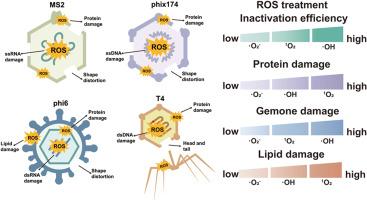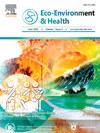Heterogeneity in susceptibility of viruses with different structures to various reactive oxygen species: Kinetics and biological mechanisms
IF 17.6
引用次数: 0
Abstract
Waterborne viruses have caused outbreaks of related diseases and threaten human health, and advanced oxidation processes (AOPs), as clean and efficient technologies, have received widespread attention for their excellent performance in inactivating viruses. However, heterogeneity in susceptibility of structurally distinct viruses to various reactive oxygen species (ROS) is unclear. This study first measured the heterogeneity in inactivation kinetics and biological mechanisms of four typical viral surrogates (MS2, phi6, phix174, and T4) to various ROS by visible light catalysis. Notably, the second-order inactivation rate constants of four viruses by hydroxyl radicals (·OH), singlet oxygen (1O2), and superoxide radicals (·O2−) were quite different: 109–1010, 107–108, and about 105 M−1 s−1, respectively. The susceptibility of four viruses to ROS varied significantly, in the order of phi6 > MS2 > phix174 > T4. More importantly, 1O2 can better oxidize capsid proteins. ·O2−-induced RNA damage was significantly greater than that to the DNA genome, indicating that RNA viruses are more susceptible. ·OH can strongly inactivate the four structurally distinct viruses. Furthermore, the resistance of the ROS-inactivated virus to environmental interference was assessed in detail. This study advanced the understanding of heterogeneity in susceptibility of structurally distinct viruses to various ROS and provided a valuable theoretical basis for the application of AOPs in water disinfection.

不同结构病毒对各种活性氧易感性的异质性:动力学和生物学机制
水传播病毒引起了相关疾病的爆发,威胁着人类的健康,而高级氧化工艺作为一种清洁高效的灭活技术,因其优异的灭活性能而受到广泛关注。然而,结构不同的病毒对各种活性氧(ROS)易感性的异质性尚不清楚。本研究首先通过可见光催化测定了四种典型病毒替代物(MS2、phi6、phix174和T4)对不同ROS失活动力学和生物学机制的异质性。值得注意的是,四种病毒在羟基自由基(·OH)、单线态氧(1O2)和超氧自由基(·O2−)作用下的二级失活速率常数差异很大,分别为109 ~ 1010、107 ~ 108和105 M−1 s−1左右。四种病毒对ROS的易感性差异显著,顺序为phi6 >; MS2 > phix174 > T4。更重要的是,1O2可以更好地氧化衣壳蛋白。·O2−诱导的RNA损伤明显大于DNA基因组损伤,表明RNA病毒更易感。·OH能强烈灭活四种结构不同的病毒。此外,还详细评价了ros灭活病毒对环境干扰的抗性。本研究提高了对结构不同的病毒对各种活性氧易感性异质性的认识,为AOPs在水消毒中的应用提供了有价值的理论依据。
本文章由计算机程序翻译,如有差异,请以英文原文为准。
求助全文
约1分钟内获得全文
求助全文
来源期刊

Eco-Environment & Health
环境科学与生态学-生态、环境与健康
CiteScore
11.00
自引率
0.00%
发文量
18
审稿时长
22 days
期刊介绍:
Eco-Environment & Health (EEH) is an international and multidisciplinary peer-reviewed journal designed for publications on the frontiers of the ecology, environment and health as well as their related disciplines. EEH focuses on the concept of “One Health” to promote green and sustainable development, dealing with the interactions among ecology, environment and health, and the underlying mechanisms and interventions. Our mission is to be one of the most important flagship journals in the field of environmental health.
Scopes
EEH covers a variety of research areas, including but not limited to ecology and biodiversity conservation, environmental behaviors and bioprocesses of emerging contaminants, human exposure and health effects, and evaluation, management and regulation of environmental risks. The key topics of EEH include:
1) Ecology and Biodiversity Conservation
Biodiversity
Ecological restoration
Ecological safety
Protected area
2) Environmental and Biological Fate of Emerging Contaminants
Environmental behaviors
Environmental processes
Environmental microbiology
3) Human Exposure and Health Effects
Environmental toxicology
Environmental epidemiology
Environmental health risk
Food safety
4) Evaluation, Management and Regulation of Environmental Risks
Chemical safety
Environmental policy
Health policy
Health economics
Environmental remediation
 求助内容:
求助内容: 应助结果提醒方式:
应助结果提醒方式:


